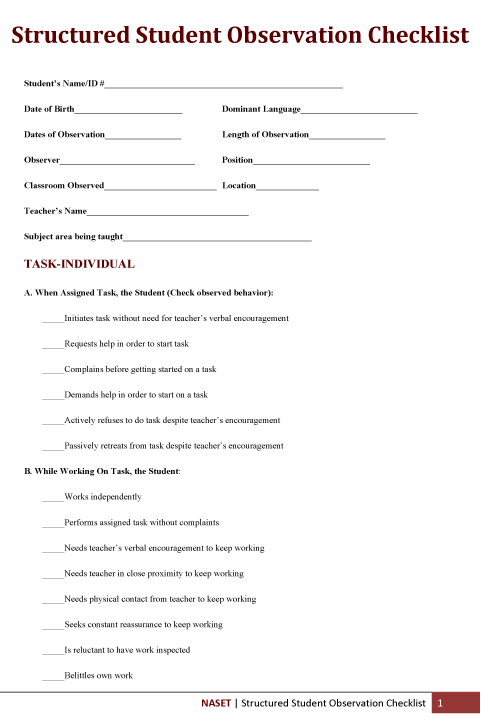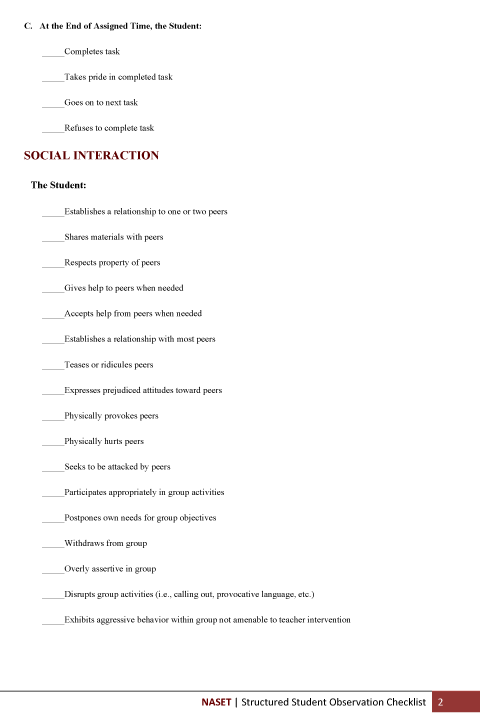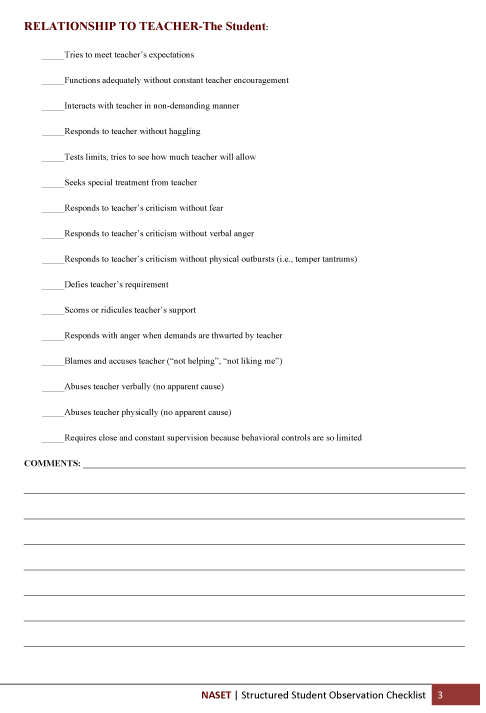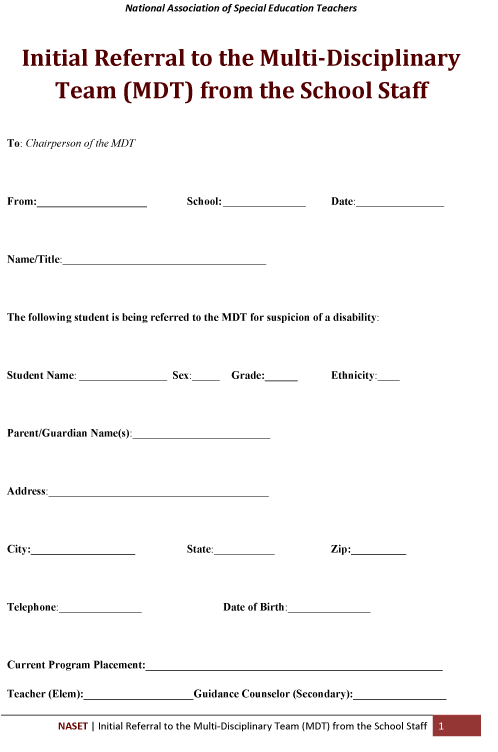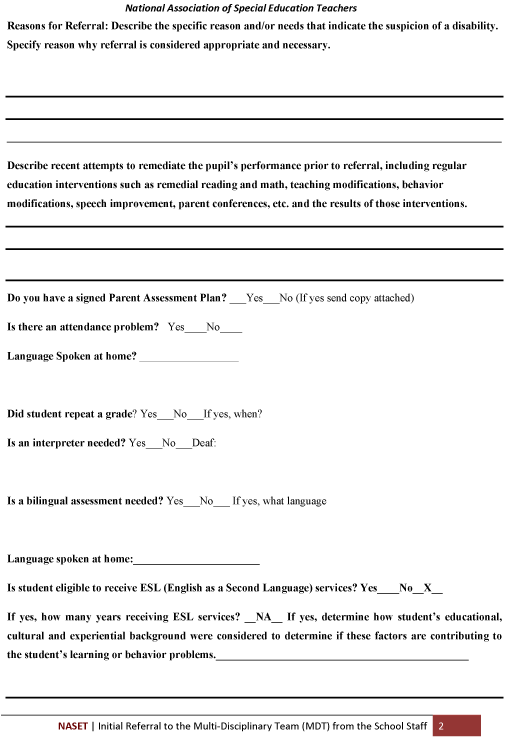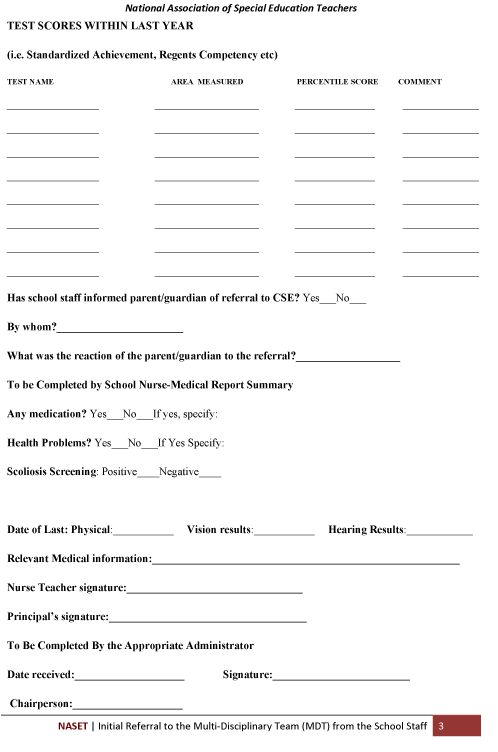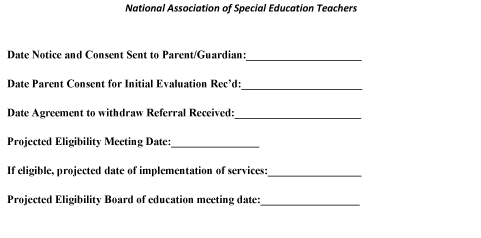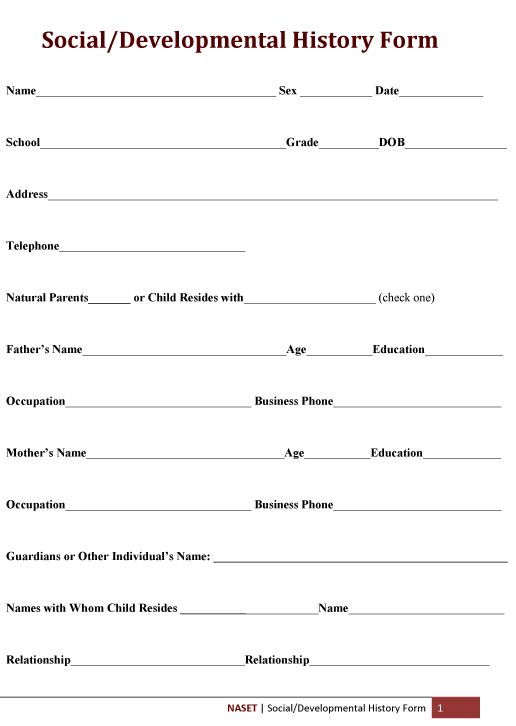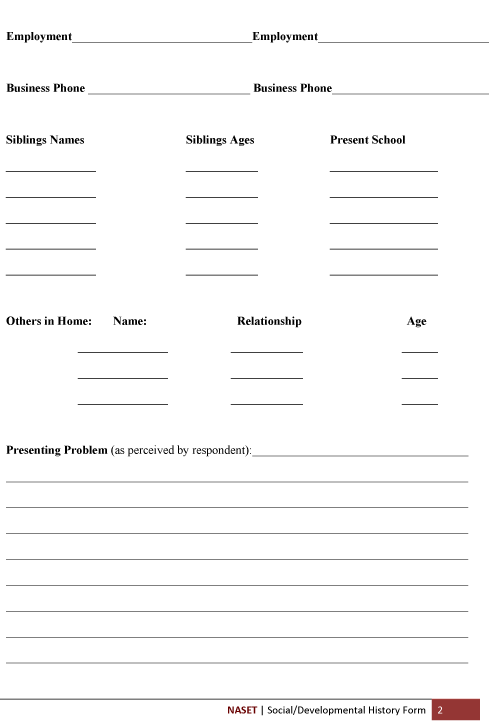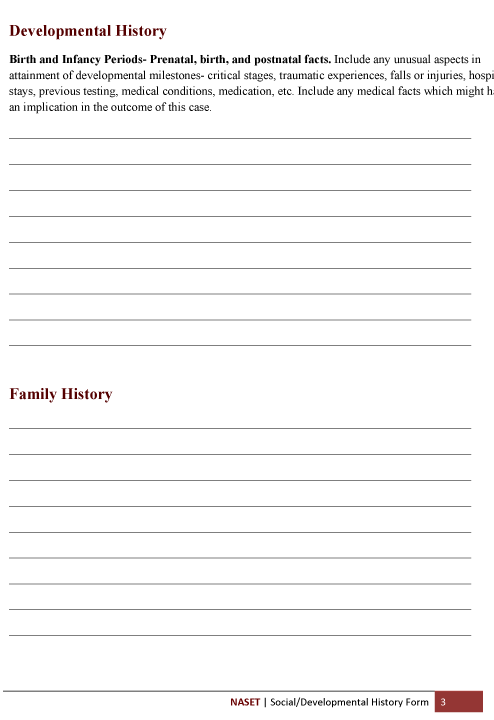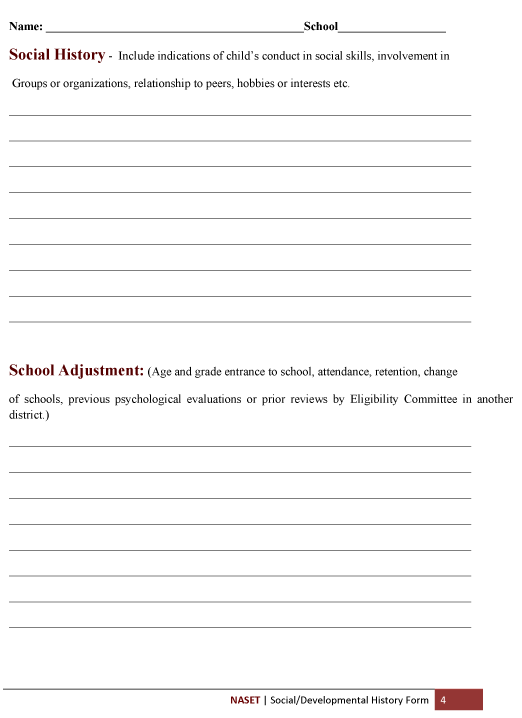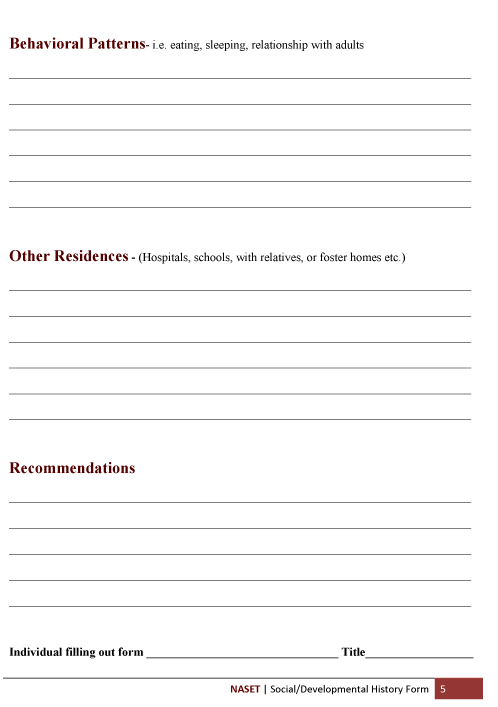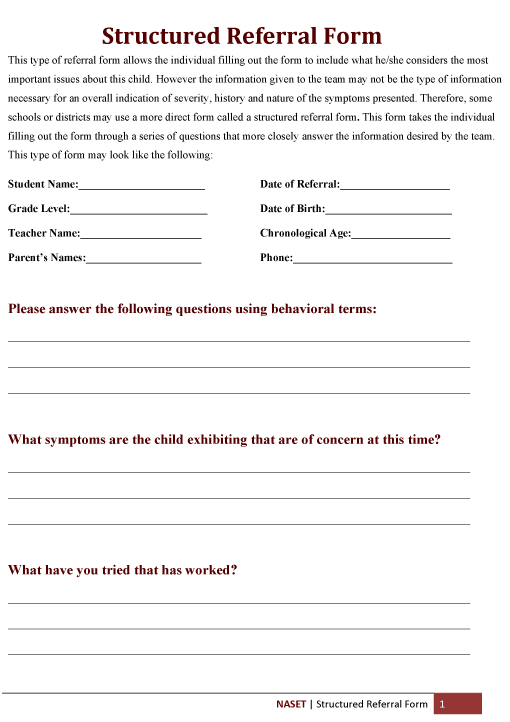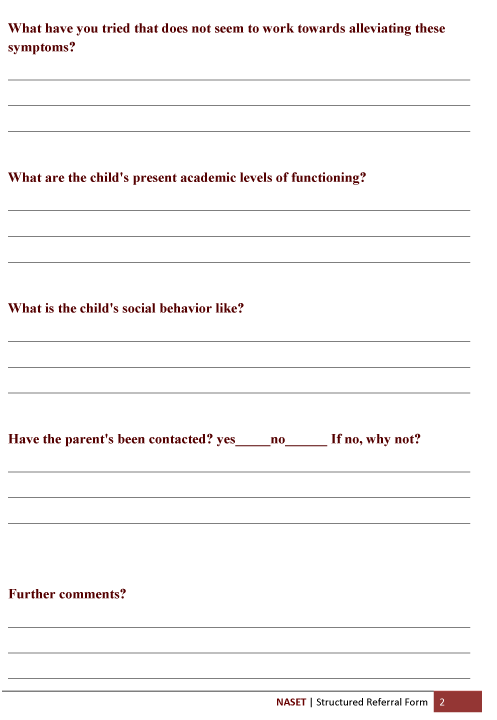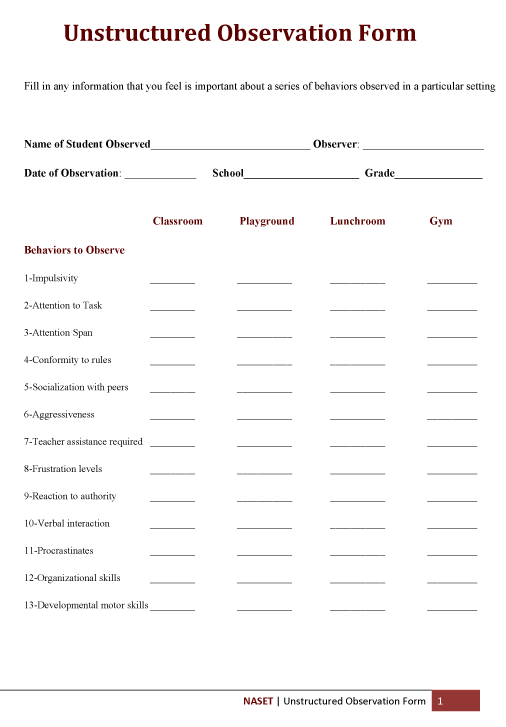Child Study Team
Checklists
• Child Study Team Checklist for Initial Student Review
• Child Study Team Pre-Referral Strategies Checklist
• IEP Committee Packet Checklist
• Obtaining School Records on a Student-Checklist
• Student Observation Checklist
• Suggested Intervention Options of the Child Study Team Used Prior To Evaluation Form
• Structured Student Observation Checklist
Forms
• Initial Referral to the MDT from the School Staff
• Social Developmental History Form
• Unstructured Student Observation Form
Checklists
Child Study Team Checklist for Initial Student Review
______ Has this child ever been referred to the CST?
Prior referral may indicate a historical disturbance or long term problem and therefore a more serious situation, especially if the same pattern exists. Situational disturbances, with no prior problems usually have a better prognosis.
_____ Do we have any prior psychological, educational, language etc evaluations?
This information is very important so that child is not put through unnecessary testing. These reports also offer the team another perspective on the problem.
_____ What are the comments from past teachers?
Never assume that the child is always the problem. Obtaining comments from past teachers may give a different picture and may also help pinpoint the changes that have led to the referral. A child who has had positive teacher feedback for the past four years and all of a sudden begins to deteriorate may have experienced something over the summer, experienced changes in the home or may be having a personality conflict with the teacher.
_____ Is anyone familiar with other family members?
Family patterns of behavior may help define contributing factors to the child’s problem. It may also offer the team some experience on the best approach to take with this family.
_____ What is going on at home?
Many symptoms in school may be the result of tension or problems emanating from the home. If confused as school related problems the true issue will be overlooked and you will be treating symptoms, not problems. Home issues affect every child and some more than others. A brief conversation by the classroom teacher can possibly find out situational disturbances (brief, but intense patterns of tension i.e. loss of a job, death of a relative, separation etc.) that may be causing the child to have difficulty focusing or performing in school.
_____ What does the developmental history look like?
A child’s developmental history can be like a fingerprint in determining possible causes or influences that may be contributing to the present problem. A thorough intake that covers all areas of a child’s history is a crucial factor in the proper diagnosis of a child’s problems. A look at developmental milestones, traumatic experiences, hospitalizations, prior testing etc. offer us a closer look at the total child.
_____ Are there any medical issues we need to be aware of at this time that might impact on this case?
These issues are crucial and the existence of medical problems should always be determined first. Difficulties with hearing, eyesight, taking medication, severe allergies etc. may be significant contributors to poor performance and may be masked as “unmotivated”, “lazy”, “stubborn”, and so on.
_____ When was the last time both vision and hearing were checked?
These two factors should be ruled out immediately as having any influence on the presenting problem. If the child has not been evaluated in either area within at least one year, or symptoms indicate possible visual or auditory involvement i.e. squinting, eye fatigue, failure to hear directions etc. then a retest in indicated.
_____ Has anyone observed this child?
The observation should always be a piece of the contributing information presented to the CST. One member, usually the psychologist, social worker, guidance counselor, or special education teacher, should observe the child in a variety of situations prior to the first CST meeting. It is very important for the team to know how this child functions in structured and unstructured settings.
_____ Do we have samples of his class work?
Samples of class work over a period of time offer a clearer overview of the child’s abilities and attitude towards class work. This also gives several team members an opportunity to observe possible academic symptoms that may first appear in written work.
_____ Has the parent been notified of the teacher’s concerns?
he team should not be the one to notify the parent that a problem may exist. It is the responsibility of the classroom teacher to alert the parents that he/she is concerned and would like a closer look by the CST. A parent does not have a legal right to refuse such a request since it is considered a normal school procedure. The parent should also be notified by the teacher that someone from the team will be in touch with them to gather more information and to review any findings.
Download a PDF Version of this checklist – CLICK HERE
Child Study Team Pre-Referral Strategies Checklist
_____ Team Meeting with Teachers
_____ Parent Interview
_____ Classroom Management Techniques
There are times when the real issue may not be the child, but rather in the teaching style of the classroom teacher i.e. unrealistic expectations, critical, overly demanding. If that is the case, then help for the teacher can come in the form of classroom management techniques. These include:
_____ Display daily class schedule with times so the student has a structured idea of the day ahead
_____ Change seating
_____ Seat student with good role models
_____ Use peer tutors when appropriate
_____ Limit number of directions
_____ Simplify complex directions
_____ Give verbal as well as written directions
_____ Provide extra work time
_____ Shorten assignments
_____ Modify curriculum
_____ Identify and address preferred learning styles
_____ Provide manipulative materials
_____ Provide examples of what is expected
_____ Use color coding of materials to foster organizational skills
_____ Develop a homework plan with parental support
_____ Develop a behavior modification plan if necessary
_____ Uses lots of positive reinforcement
_____ Use technology as an aide
_____ Help Classes
_____ Remedial Reading or Math Services
_____ In-School Counseling
_____ Daily/Weekly Progress Reports
_____ Hearing Test – Symptoms that require this option:
_____ child asks you to repeat frequently
_____ child consistently misinterprets what he/she hears
_____ child does not respond to auditory stimuli
_____ child slurs speech, speaks in a monotone voice, or articulates poorly
_____ Vision Test – Symptoms that may require this option:
_____ child turns head when looking at board or objects
_____ child squints excessively
_____ child rubs eyes frequently
_____ child holds books and materials close to the face or at unusual angles
_____ child suffers frequent headaches
_____ child avoids close work of any type
_____ child covers an eye when reading
_____ child consistently loses place when reading
_____ Disciplinary Action
_____Medical Exam
_____Change of Program
_____Consolidation of Program
_____Referral to Child Protective Services
_____Teacher made tests
_____Further observation
_____Screening tests
Download a PDF Version of this checklist – CLICK HERE
Download a PDF Version of this checklist – CLICK HERE
Obtaining School Records on a Student – Checklist
The school usually has a wealth of information about all children, distributed among a number of people and a number of records. Gathering this information after a referral and prior to evaluation may reduce the need for testing and will provide a very thorough picture of the child and his/her abilities and patterns. Investigating the following areas will contribute to the overall “picture ” of the child:
_____ Prior Teacher reports: Comments written on report cards or in permanent record folders may provide a different view of the child under a different style of teaching. Successful years with positive comments may be a clue to the child’s learning style and may provide you with information about the conditions under which the child responds best.
_____ Reports of prior parent-teacher interviews: Prior conferences between previous teachers and parents may provide you with information that may be important in understanding the child’s patterns and history.
_____ Cumulative school record: This particular file may contain information from standardized achievement test results, group IQ results, teacher comments dating back to kindergarten, records from previous schools, individual reading test results and family information.
_____ Group IQ test information: This information is usually found in the permanent record folder. Many schools administer this type of test i.e. Otis Lennon, Henmon Nelson in grades 3, 6 and 9 so look carefully. Within the past year or so the term School Abilities Index has replaced the term “IQ” or Intelligence Quotient.
_____ Standardized test scores: These scores should be analyzed for patterns of strengths and deficiencies. The older the child, the greater the number of scores that one can compared.
_____ Report card grades: These materials can be reviewed for comments, patterns of productive and difficult years.
_____ Attendance records: These records should be reviewed for patterns of lateness or absence. If such patterns exist the reasons should be investigated to rule out medical causes (hospital stays, illnesses), psychological causes (dysfunctional family patterns, school phobia etc) or social causes (peer rejection or isolation).
_____ Number of schools attended: There are times when a child will be enrolled in several schools in several years. The reasons for the many moves should be investigated and may AD/HD to the child’s adjustment difficulties.
_____ Prior teacher referrals: Investigate school records for prior referrals from teachers. There are times when a teacher will refer but no action may have been taken due to time of year, parent resistance, delay in evaluation procedures etc. These referrals may still be on file and may reveal information that can be useful.
_____ Medical history in the school nurses office: Investigate these records for indications of visual or hearing difficulties, prescribed medication that may have an effect on the child’s behavior (i.e. antihistamines), medical conditions in need of attention or that can be contributing to the child’s present situation.
_____ Prior psychological, educational or outside reports: Investigate the possibility of any prior testing that may exist in one of the school folders (i.e. psychological).
Download a PDF Version of this checklist – CLICK HERE
Student Observation Checklist
_____ Is there a difference between the nature of behaviors in a structured setting i.e. classroom and an unstructured setting i.e. playground?
This factor may shed light on the child’s need for a more structured environment in which to learn. Children who do not have well developed internal control systems need a highly structured environment to maintain focus and appropriate behavior. Some children cannot shift between structured and unstructured and back again. They may not possess the internal monitor which regulates conformity and logical attendance to rules. These children may be more successful in a structured play setting set up by teachers during the lunch hour.
_____ Does the child seem to respond to external boundaries?
This factor is important to the teacher since it is a monitor of potential learning style. If a child who lacks internal controls does conform to external boundaries i.e. time out, teacher proximity during work time, then this factor needs to be taken into consideration when prescribing classroom management techniques. When the child conforms to such boundaries, then his/her behavior is a message for what works for him/her.
_____ What is the child’s attention span during academic tasks?
Attention span at different ages is measured normally in minutes or hours. You should become aware of the normal attention span for children of all ages and compare the child over several activities and days to see if a pattern of inattention is present. If the attention span is very short for someone of his/her age then modifications to work load i.e. shorter but more frequent assignments may have to be included.
_____ Does the child require constant teacher supervision or assistance?
A child who requires constant teacher supervision or assistance is a child who may be exhibiting a wide variety of possible symptomatic behavior which may be resulting from but not limited to attention deficit disorder, processing problems, emotional difficulties involving need for attention, need for control , high anxiety ,internal stress , limited intellectual capacity, hearing problems etc. All of these areas need to be checked out and a good evaluation should determine the root of such behavior. However the key is always the frequency, intensity and duration of such symptoms.
_____ Does the child interact appropriately with peers?
Observing children at play can tell us a great deal about self esteem, tension levels, social maturity, physical development, and many other factors. Social interaction is more common in children over the age of 6 or 7 while parallel play is still common in younger children. Appropriate social interaction gives us insight into the child’s own internal boundaries and organization. A child who always needs to control may really be masking high levels of tension. The more controlling a child is the more out of control they are feeling. A child who can appropriately conform to group rules, delay his/her needs for the good of the team, conform to rules and various changes or inconsistencies in rules, may be a child who is very self-assured and has low anxiety levels. The opposite is most always typical of children at risk. However, one should always consider developmental stages since certain behaviors, such as control, may be more typical at early ages.
_____ Is the child a high or low status child?
Observing a child in different settings allows us the opportunity to see the social status of the child and its impact on his behavior. Low status children as often seen in children with learning disabilities are more apt to feel insignificant and therefore fail to receive positive social cues which help reinforce feelings of self esteem.
Regardless of the form used you will need to be very familiar with this part of the process if you are called upon by the team to gather this information.
Download a PDF Version of this checklist – CLICK HERE
Suggested Intervention Options of the Child Study Team Used Prior To Evaluation Form
_____ Child Study Team discussions: This procedure should be used so that several staff members are able to view the symptoms and provide a variety of preventive suggestions prior to evaluation.
_____ Team meeting with teachers: Sometimes a group meeting with all the child’s teachers can prevent the need for further involvement. Once a pattern is identified, it may be handled in a variety of ways without the need for more serious intervention.
_____ Parent interviews: Meeting the parent(s) is always recommended for a child having some difficulty in school. This initial meeting can be informal and may be just for the purpose of clarifying certain issues and gathering pertinent information that may help in the classroom.
_____ Classroom management techniques: There are times when the real issue may not be the child, but the style of the classroom teacher. If that is the case, then help for the teacher can come in the form of classroom management techniques. There are many classroom techniques and modifications that should be tried before taking more serious steps.
_____ Help classes: Some schools provide extra non-special education services, such as help classes that may be held during lunch, or after school. They would assist a child by clarifying academic confusion that could lead to more serious problems if not addressed.
_____ Remedial reading or math services: These types of services do not require a review by the Eligibility Committee. Remedial reading or math classes are not special education services and can be instituted as a means of alleviating the child’s academic problems.
_____ Speech and Language Services: There are times when children who have not been classified by the Eligibility Committee as disabled encounter mild developmental speech and/or language difficulties that can be remediated with this type of intervention.
_____ Recommendation for in-school counseling: When a pattern occurs that temporarily interferes in a child’s ability to concentrate, remember, or attend to tasks. The school psychologist may want to institute in school counseling with the parent’s involvement and permission. This recommendation should only be instituted with issues that can resolve in a relatively short period of time. More serious issues may have to be referred to outside agencies or professionals for longer treatment.
_____ Daily/Weekly Progress reports: Sometimes children who have fallen behind academically “hide” from the real issues by avoiding reality. The use of daily progress reports for a week or two at first and then weekly reports may provide the child with the kinds of immediate gratification to get back on track.
_____ Disciplinary Action: This recommendation is usually made when the child in question needs a structured boundary set involving inappropriate behavior. It is usually used in conjunction with other recommendations if a pattern exists since such patterns of behavior may be symptomatic of a more serious problem.
_____ Medical Exam: Try to rule out any possibility of a medical condition causing or contributing to the existing problems. If the PPT feels that there is any possibility of such involvement, then a recommendation.
_____ Change of Program: This recommendation usually occurs when a student may be placed in a course that is not suited to his/her ability or needs. If a student is found to have a low IQ and is in an advanced class and failing then the student’s program should be changed to include more accelerated or modified classes.
_____ Consolidation of program: If a child’s available energy level is extremely low then a temporary consolidation or condensing of the program allows for the possibility of salvaging some courses since his/her available energy does not have to be spread so thin.
_____ PINS Petition: A PINS petition stands for “Person in Need of Supervision ” and is a family court referral. This referral can be made by either the school or the parent and is usually made when a child under the age of 16 is out of control in terms of attendance, behavior or some socially inappropriate or destructive pattern.
_____ Referral to Child Protective Services: A referral to Child Protective Services is mandated for all educators if there is a suspicion of abuse or neglect. Referrals to this service may result from physical, sexual or emotional abuse, or educational, environmental or medical neglect.
Download a PDF Version of this checklist – CLICK HERE
Forms

